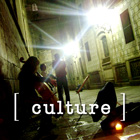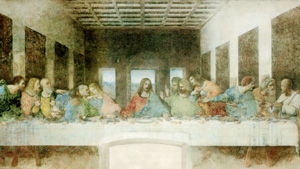
|
THE POPULAR WORK OF FICTION IS NOT WHAT SOME OF ITS CRITICS SEEM TO THINK 18 May 2006 Dan Brown's bestselling novel is not, contrary to popular opinion, primarily about conspiracy theories. Conspiracies do figure in the plot, as they have in his other books, but they are too simplistic an explanation for the popularity of the book, too much a device to explain what in the substance of the book attracts special attention among readers. The question on many lips in today's media environment is: why has the DaVinci Code done so well in so many markets? The answer is, it would seem, that it addresses questions of meaning, truth, humanity and doctrine. And these elements together comprise what we tend to treat as our lived "reality". I don't claim the book is a work of literature for the ages, harbinger of a revolutionary cultural movement or a cutting edge philosophical examination of what truth is, but it does appear to want to address questions about inherited assumptions about meaning, the validity of ideas tested against history, and societal biases about gender, morality and tradition. The book does not outwardly claim to expose any conspiracy (though a wordy exposition is part of the technique of the narrative), in part because it is fictional, but also in part because the conspiracies involved are not hugely in doubt as the mystery unfolds. They are rooted in the fictional story as assumptions and as background for the understanding of the characters and to enhance the drama of the situations in which they find themselves. What's more, it is not relevant whether the facts presented as part of the book's plot are true or not; in the end, it defames no modern religion in any serious way, if you read the text carefully. And its central claims do not diminish in any way the teachings of Christianity; they simply call into question the historicity of certain doctrines, which do not affect the moral message of Christ. What's relevant to the book's success, to its broad market appeal, is that it seems to work fairly hard at recovering from traces of cultural history an idea of meaning still infused in today's world. This is not so much about conspiracy, or even about mystery, but about a fascination of the mortal intellect: We aspire to conceive of some manner in which we can know that what we value will survive beyond the term of our mortal existence, be that faith, love, creative work, or an idea of the world, crafted through cultural media. To be able to recover timeless meaning, artfully stored in and transmitted through complicated coding, which the human mind is nevertheless able to decipher, demonstrates the possibility of such a communication from the past into the future. The book engages this wish and this process by explaining details, making the esoteric into at least a lamplight and that sort of illuminated landscape, however much based in fiction or a conflation of legend and historical innuendo, appeals to the human mind. As such, it satisfies the reader, intellectually and emotionally. It also reminds us that science has informed the modern structure of society. Aside from the theme of Mary Magdalene and the pre-Christian symbolism tied to her and hinting at the virtues of a knowledge of nature, there is the undercurrent of science as a defense against ignorance: From the once highly specialized knowledge of church building, defended and covered up by early "masons", to the ingenious devices of DaVinci's invention used to "encrypt" actual physical messages, demonstrating that a world written in code need not be a world of insecure beings or unknowable peril. The technical information —again, true or otherwise— gives the book an essence tied to problem solving. The element of human resolution of overarching mystery lends a sort of comfort to the psyche, with chaos reduced and diminished by the exercise of genius, something entirely human but which references for the believer a hand for divine creation in the reliability of physical laws. There is in many ways a departure from the idea of genius in today's popular culture, an under-emphasis on the mystery of complex human creativity, as tied to the uncanny ability of the human intellect to work out daunting problems. For instance, it is not all that impressive that Einstein worked out his still enigmatic theory of relativity, if one assumes he was a "specialist" and had all the necessary training to do precisely that. But consider that he invented a whole new kind of physics in order to able to propose the theory, that he did all the proofing in his own mind, with no hard physical evidence and had to first understand there was a question to ask, which no one else had ever asked, before he could answer it, and his feat becomes far more awe-inspiring. By working with the brilliant artistic creations of Renaissance masters, the DaVinci Code taps into this taste we have for evidence that the human intellect —which comprises not only what we can do, but what we are— can approach great truths, whether that's a spiritual truth or a not-very obvious physical phenomenon. I make no apologies for the book's assertions about secret societies, or even about sometimes secretive sects in today's Church, simply because the information needed to prove or disprove those assertions is not available... and, because as a work of fiction, its lacking any sinister aim to undermine any cultural or ethnic group is enough to make fact-claims less than seriously relevant. I seek only to illustrate to some degree why it would appear that people who have read the book find it attractive as an intrigue, and for instance, why many Catholics do not take offense at its plot or its references to history or to unproven theories. As an artful examination of secret societies on British television recently pointed out, the examination of conspiracies (theoretical or fully demonstrable) intrigues the human mind for two important reasons: 1) because we feel a need to fill in our knowledge of things as yet unexplained, and 2) because we are social animals, and our brains are developed to spend a lot of time and energy focused on figuring out the meaning of other people's behavior, the nature of social networks and the stability of our own position within society. In fact, the scintillating lure of conspiracy is as much a motor for the doctrinaire opposition to the book among people apparently convinced it will undermine their faith as it is for characters working their way through the book's intricate plot. It seems a temptation for those opposed to the book to claim they "recognize" in its contents a pattern of discrimination against their beliefs, in which they find parallels to historical movements and to conflicts that were violent in nature. There is a clear tendency to associate the perceived "threat" of a work of fiction to established doctrine with presumptions about certain shadowy elements arrayed against those who hold that doctrine to be true. The temptation does not, however, make it so, and the unwillingness of some to tolerate a work of fiction does not mean any religious community is in jeopardy. Ultimately, one can read the book without believing the Church is involved in anything sinister and without believing there are sweeping historical conspiracies to conceal information. The temporary "suspension of disbelief" which we engage in following a fictional tale does not equate to long-term personally held belief; one does not erase the other... nor, as would appear, is it meant to. Many cultural and even religious groups report an increase in general interest: more visits to the Louvre, sudden popularity of London's Temple Church, Scotland's Rosslyn chapel or France's Saint Sulpice, books on theology borrowed from libraries and bought in bookstores, histories of ancient and medieval times, religious and artistic figures gaining a wider audience. Not all of that is attributable to Dan Brown, but it's encouraging to know that general interest in history, culture, tradition and even the pursuit of truth, can all be made more vibrant by reading and that reading can still invigorate an increasingly visual and technological society. Once you consider that the book can be read not first as a shocking exposé of sinister dealings and not first as a blasphemous tract, it is clear that the plot relies on the project of the central characters, a scholar and a detective, to examine evidence relating to a hidden story. It is a layered narrative, an old form of storytelling and it harkens back to information we are familiar with but are (as the book argues) taught not to see. The idea, whether the evidence is historical fact, historical speculation or pure fiction, that a missing element in the dominant structures of today's society might be an ancient reverence for the feminine in nature, and for the female in human society, is not in itself against religious doctrine or a shocking conspiracy theory. It is instead a useful way to take the reader through a meditation on the nature of reality and on the state of societal values, their coherence and integrity. And that, given its being rooted in traditions as interwoven into Western culture as the Virgin Mary, the life of Christ, the Gospels' narrative, and of course the genius of Leonardo DaVinci, provides the reader with a way of reflecting on what role culture and doctrine have in shaping both historical reality and the present. These are entirely valid issues to examine as a general practice and subjects which theologians and religious historians study professionally. The book's linking Mary Magdalene and her portrayal in the apocryphal and gnostic gospels to the pagan goddess tradition makes sense in considering the possibility that those texts, written out of the Christian canon and suppressed in fact for centuries, might have something to tell us. Whether they do or not, whether they contain history or diverge from it, is another matter. But doubt on that account is not reason enough to suppress a rich cultural creation which, for all its faults and despite so much controversy, has stirred an interest in the public to ask questions and to seek to learn more. [s] |
|||||||||
|
||||||||||


